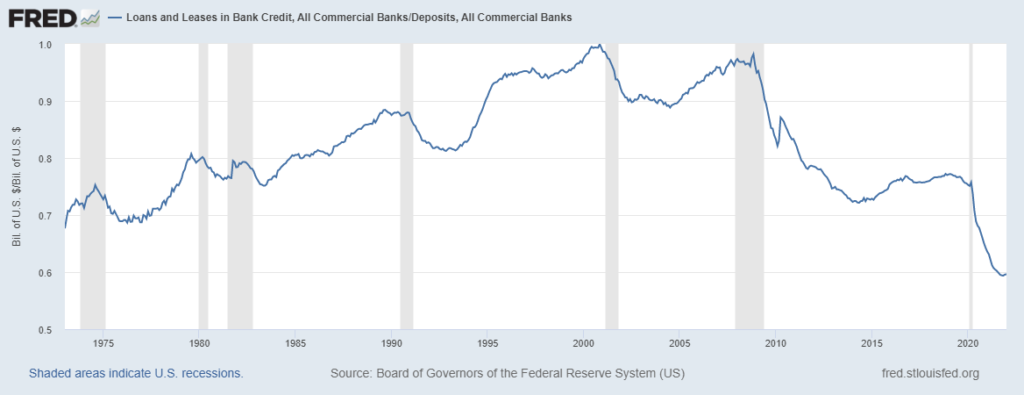Economists are concerned that a shift in Federal Reserve policy could trigger a recession.
As the Fed prepares to raise interest rates, bears point out that since 1950, the Fed has moved to raise rates 13 times. Ten resulted in recessions.
These recessions may occur because less money available is for lending as the Fed tightens.
But that shouldn’t be the case this time. Here’s why.
There’s plenty of money waiting to be moved into productive assets. Trillions of dollars are locked up in banks.
The chart below shows the percentage of bank deposits that are used for loans. It’s at the lowest level since the data series became available in 1973.
Banks Are Hoarding Cash

Source: Federal Reserve.
It looks like banks are sitting on piles of figurative cash. Banks have used that money to issue loans for centuries. In normal times, banks need to make loans to earn a profit. Those loans fund business expansion, mortgages and consumer spending that grow the economy.
But that’s not happening right now.
Fed Rate Hikes May Force Banks’ Hand
The chart shows that the ratio of loans to deposits rose steadily until the financial crisis in 2008. Since then, banks have lent a smaller and smaller share of their deposits.
Fed policy is one reason for that. Since 2008, the Fed has paid banks interest on balances held at the Fed. Rather than taking risks, banks can collect risk-free profits holding cash.
As rates rise, that risk-free rate will be less attractive to banks. This could force banks to lend money to businesses and consumers. That could set off a new wave of economic expansion.
If the loan-to-deposit ratio increases to 80%, the level seen in the early 1990s, it would add $3.6 trillion to the economy.
That’s more than the $3.1 trillion Congress appropriated in last year’s American Rescue Plan and the Infrastructure Investment and Jobs Act.
Imagine the growth of the economy if Americans decide how to allocate trillions of dollars instead of Congress. We may just see that in the next year.
Michael Carr is the editor of True Options Masters, One Trade, Peak Velocity Trader and Precision Profits. He teaches technical analysis and quantitative technical analysis at the New York Institute of Finance. Follow him on Twitter @MichaelCarrGuru.
Click here to join True Options Masters





